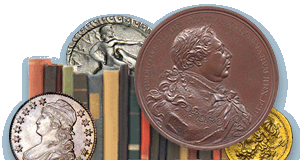
PREV ARTICLE
NEXT ARTICLE
FULL ISSUE
PREV FULL ISSUE
DENMARK LETS AMATEURS DIG FOR TREASUREDenmark has a growing program similar to Britain's Treasure Trove law, prompting metal detectorists to search for artifacts. There's only one numismatic illustration in this article, but it's an interesting read. Here's an excerpt - see the complete article online. -Editor
These embossed runes are the oldest known written mention of Odin, the Norse god of war and ruler of Valhalla. Ginnerup's bracteate, which archaeologists describe as the most significant Danish find in centuries, extended the worship of Odin back 150 years—and it's all because Ginnerup received a metal detector as a birthday present from his father-in-law. Many other European countries have prohibited or heavily restricted hobbyist metal detecting, but Denmark has embraced it, creating a system for members of the public to hand over finds to government archaeologists. The result has been an embarrassment of riches, with more than 20,000 items turned in annually in recent years. The curators assigned to identify and catalog the artifacts can't dream of keeping up, but the fruits of their collective labor are clear: whereas neighboring countries have only vague sketches of the past, metal detectorists have filled in the ancient map of Denmark with temple complexes, trade routes and settlements that would have otherwise been lost to history. "Private detectorists have rocketed Denmark ahead of its neighbors in archaeological research," says Torben Trier Christiansen, curator of archaeology at Denmark's North Jutland Museums. "There's nothing ‘amateur' about them." As Sweden drafted legislation to heavily restrict private metal detecting, one man decided Denmark already had a relevant law on the books—from 1241. Olaf Olsen, the director of the Danish National Museum in the 1980s, championed the idea that detection finds could fall under a medieval law that declared all precious metals without a clear owner the property of the crown. Olsen's interpretation of the Danefæ ("Danish treasure trove") law led to one of the most permissive approaches to metal detecting in Europe. Today anyone can metal detect in Denmark without a permit as long as they have the landowner's permission and agree to turn over any potentially historic finds to the government. It's a classically Danish system built on social responsibility—in a country where people regularly leave babies to nap outside in their strollers, it's no wonder the government trusts the public with treasure. It wasn't until about 10 years ago, though, that interest in metal detecting really surged, thanks to television shows and social media. In 2013 about 5,600 items were turned in for evaluation as potential Danefæ. By 2021 that number had skyrocketed to more than 30,000. That's a lot of nonarchaeologists digging holes. But in Trier's opinion, Danish archaeologists benefit from all these boots on the ground. Detectorists hand over their artifacts to Denmark's 28 local archaeology museums—an astonishing number for a country one-third the size of New York State. It's up to local archaeologists such as Trier to designate sites of interest before they're destroyed by farming or construction and to identify and record the finds before they're passed on to the central Danefæ department at the National Museum. Trier says he has about 300 detectorists who regularly turn in finds to him. "They can often tell even from a teeny sound the detector makes what kind of an object and how deep it is," he notes. The oldest wing of the National Museum, in downtown Copenhagen, is home to Denmark's treasure bureaucrats. It's up to the curators of the Danefæ department to identify the thousands of objects streaming in from the fields every year and decide which are worthy of joining the museum's research collection—and which will earn their finders a monetary reward.
To read the complete article, see:
Wayne Homren, Editor The Numismatic Bibliomania Society is a non-profit organization promoting numismatic literature. See our web site at coinbooks.org. To submit items for publication in The E-Sylum, write to the Editor at this address: whomren@gmail.com To subscribe go to: Subscribe All Rights Reserved. NBS Home Page Contact the NBS webmaster 
|


